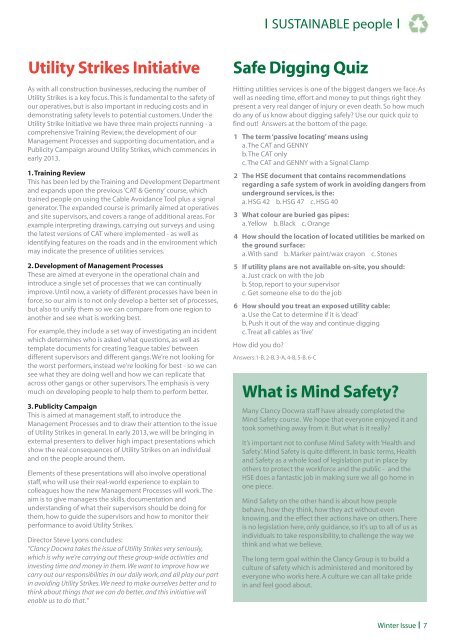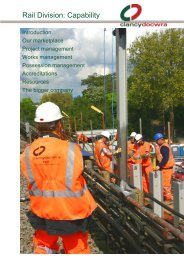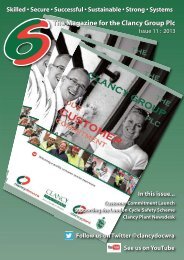Mark Sewell
6S08 Size:3 MB Type:PDF - Clancy Docwra
6S08 Size:3 MB Type:PDF - Clancy Docwra
- No tags were found...
Create successful ePaper yourself
Turn your PDF publications into a flip-book with our unique Google optimized e-Paper software.
I SUSTAINABLE people I<br />
Utility Strikes Initiative<br />
As with all construction businesses, reducing the number of<br />
Utility Strikes is a key focus. This is fundamental to the safety of<br />
our operatives, but is also important in reducing costs and in<br />
demonstrating safety levels to potential customers. Under the<br />
Utility Strike Initiative we have three main projects running - a<br />
comprehensive Training Review, the development of our<br />
Management Processes and supporting documentation, and a<br />
Publicity Campaign around Utility Strikes, which commences in<br />
early 2013.<br />
1. Training Review<br />
This has been led by the Training and Development Department<br />
and expands upon the previous ‘CAT & Genny’ course, which<br />
trained people on using the Cable Avoidance Tool plus a signal<br />
generator. The expanded course is primarily aimed at operatives<br />
and site supervisors, and covers a range of additional areas. For<br />
example interpreting drawings, carrying out surveys and using<br />
the latest versions of CAT where implemented - as well as<br />
identifying features on the roads and in the environment which<br />
may indicate the presence of utilities services.<br />
2. Development of Management Processes<br />
These are aimed at everyone in the operational chain and<br />
introduce a single set of processes that we can continually<br />
improve. Until now, a variety of different processes have been in<br />
force, so our aim is to not only develop a better set of processes,<br />
but also to unify them so we can compare from one region to<br />
another and see what is working best.<br />
For example, they include a set way of investigating an incident<br />
which determines who is asked what questions, as well as<br />
template documents for creating ‘league tables’ between<br />
different supervisors and different gangs. We’re not looking for<br />
the worst performers, instead we're looking for best - so we can<br />
see what they are doing well and how we can replicate that<br />
across other gangs or other supervisors. The emphasis is very<br />
much on developing people to help them to perform better.<br />
3. Publicity Campaign<br />
This is aimed at management staff, to introduce the<br />
Management Processes and to draw their attention to the issue<br />
of Utility Strikes in general. In early 2013, we will be bringing in<br />
external presenters to deliver high impact presentations which<br />
show the real consequences of Utility Strikes on an individual<br />
and on the people around them.<br />
Elements of these presentations will also involve operational<br />
staff, who will use their real-world experience to explain to<br />
colleagues how the new Management Processes will work. The<br />
aim is to give managers the skills, documentation and<br />
understanding of what their supervisors should be doing for<br />
them, how to guide the supervisors and how to monitor their<br />
performance to avoid Utility Strikes.<br />
Director Steve Lyons concludes:<br />
“Clancy Docwra takes the issue of Utility Strikes very seriously,<br />
which is why we're carrying out these group-wide activities and<br />
investing time and money in them. We want to improve how we<br />
carry out our responsibilities in our daily work, and all play our part<br />
in avoiding Utility Strikes. We need to make ourselves better and to<br />
think about things that we can do better, and this initiative will<br />
enable us to do that.”<br />
Safe Digging Quiz<br />
Hitting utilities services is one of the biggest dangers we face. As<br />
well as needing time, effort and money to put things right they<br />
present a very real danger of injury or even death. So how much<br />
do any of us know about digging safely? Use our quick quiz to<br />
find out! Answers at the bottom of the page.<br />
1 The term ‘passive locating’ means using<br />
a. The CAT and GENNY<br />
b. The CAT only<br />
c. The CAT and GENNY with a Signal Clamp<br />
2 The HSE document that contains recommendations<br />
regarding a safe system of work in avoiding dangers from<br />
underground services, is the:<br />
a. HSG 42 b. HSG 47 c. HSG 40<br />
3 What colour are buried gas pipes:<br />
a. Yellow b. Black c. Orange<br />
4 How should the location of located utilities be marked on<br />
the ground surface:<br />
a. With sand b. <strong>Mark</strong>er paint/wax crayon c. Stones<br />
5 If utility plans are not available on-site, you should:<br />
a. Just crack on with the job<br />
b. Stop, report to your supervisor<br />
c. Get someone else to do the job<br />
6 How should you treat an exposed utility cable:<br />
a. Use the Cat to determine if it is ‘dead’<br />
b. Push it out of the way and continue digging<br />
c. Treat all cables as ‘live’<br />
How did you do?<br />
Answers:1-B, 2-B, 3-A, 4-B, 5-B, 6-C<br />
What is Mind Safety?<br />
Many Clancy Docwra staff have already completed the<br />
Mind Safety course. We hope that everyone enjoyed it and<br />
took something away from it. But what is it really?<br />
It’s important not to confuse Mind Safety with ‘Health and<br />
Safety’. Mind Safety is quite different. In basic terms, Health<br />
and Safety as a whole load of legislation put in place by<br />
others to protect the workforce and the public - and the<br />
HSE does a fantastic job in making sure we all go home in<br />
one piece.<br />
Mind Safety on the other hand is about how people<br />
behave, how they think, how they act without even<br />
knowing, and the effect their actions have on others. There<br />
is no legislation here, only guidance, so it’s up to all of us as<br />
individuals to take responsibility, to challenge the way we<br />
think and what we believe.<br />
The long term goal within the Clancy Group is to build a<br />
culture of safety which is administered and monitored by<br />
everyone who works here. A culture we can all take pride<br />
in and feel good about.<br />
Winter Issue I 7














